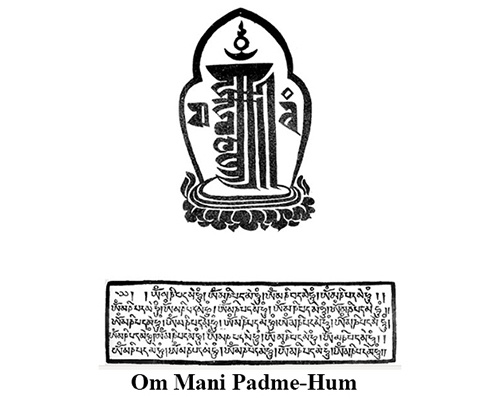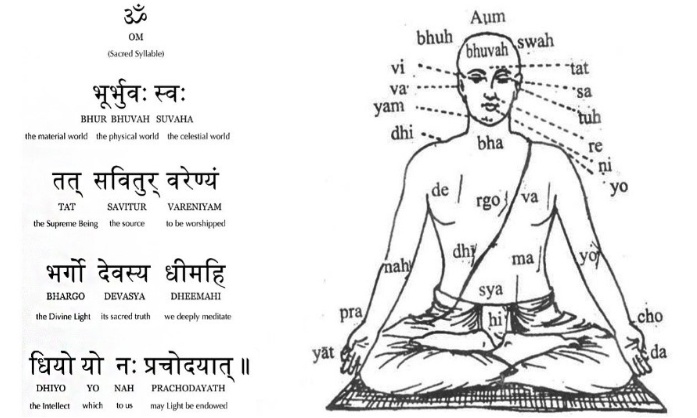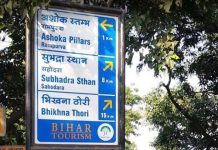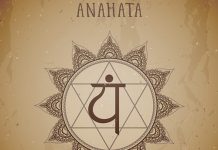It is believed that music is a gift of divine and probably for that reason all human beings throughout history have been influenced by music in their lives. This article explores the significance of word AUM or mantra in Indian culture which is the foundation of classical music. The author further examines the role of music in achieving the state of transcendence and the impact of music in our life.
Music is a fundamental attribute of the human species. Virtually every known society, throughout history has had some form of music, from the most primitive to the most advanced. In the earliest civilization’s humans were already playing such complex instruments as bone flutes, jaw harps and percussive instruments (Weinberger, 2004).
Whether we sing in tune or not, we all sing and hum; in rhythm or not, we clap and sway; in step or not, we all dance. It is not easy to find someone who does not feel this connection to music. Music also has the potential to evoke happy and emotional feelings and can change the mood of an individual. Babies begin to respond to music while they are still in the womb. At the age of 4 months, dissonant notes at the end of a melody will cause them to squirm and turn away. If they like a tune, they may coo (Cromie, 2001). At a very early age, this skill is developed by the music of the culture in which a child is raised. Every culture has their own instruments used for music and the way people use them, the way people sing, the way people sound and even the way they hear and understand sounds.
This exploratory study examines the origin and significance of the OM mantra, which is also known as a sacred sound, by exploring ancient Indian Vedic texts. The study also describes how Indian Rishis (Scholars) brought Tantric Buddhism, which included OM as part of numerous Mantras, to Tibet in the eighth century.
The study further analyses why the Indian theological and metaphysical texts put so much emphasis on the sacred sound of OM, and examines how and why the sacred sound of OM became the basis of Indian devotional Sangita and Classical Music.
The study further explores the link between music, transcendence, divinity and the human brain, in order to understand whether we all have this built-in biological circuitry that is only active in those practicing, or it is a biological accident.
Personal Experience and Motivation for the Study
Like billions of people, I am not a trained singer but I do like listening to music. I was not able to sing until April 2017, when at a family gathering, I was given a Karaoke.
While signing that night I felt that sound or words were flowing through my throat smoothly although, at time, not in a rhythm. I couldn’t believe myself but I was happy. Next week, I bought a Karaoke machine and since then I sing whenever I get time.
I understand the changes in my throat were due to energy activation in my body when I was recouping health through walking in the forest/woods. To understand this, please read my paper “Exploring the potential of Human Body and Brain to Synchronise with Earth Electromagnetic Resonance and Schumann Resonance” published in the International Journal of Hinduism & Philosophy (Bist, 2019). The paper is also available at http://bgrfuk.org/.
The main aim of writing this paper is to make readers aware of the potential of human body and brain and the role music plays in changing our brain and body, which can improve our quality of life. It seems to me that the ancient scholars in India were well aware of this phenomenon.

Mantra – An ancient Indian Perspective
A mantra (Sanskrit – मन्त्र) is a sacred or spiritual sound, a syllable, word or phoneme, or a group of words in Sanskrit that is believed to provide psychological or spiritual powers to the practitioners. The original application of Mantra appears in the oldest literature of Aryan or Indo-Iranians as either Mantra in Sanskrit (Vedas) or Manthra in Old Persian (Avesta). The earliest mantras composed in Vedic Sanskrit in India are at least 5000 years old.
In Hinduism, mantras are a linguistic unit comprised of a syllable, word, or series of syllables or words in the Sanskrit language that functions as a transformative instrument of thought, speech, or action, especially when uttered during a ritual. Mantras have been used in the religious and semi-religious functions by people following Hindu tradition. Within the Hindu tradition mantras are used for several purposes, such as offering praises to deities, thanking deities, invoking a spirit presence, recalling a mythic narrative, installing a deity, inaugurating a temple, consecrating a sacred shrine, performing transition in life stage, and direct offering to the ancestors (Beck, 2009).
It is believed that without Mantra one is unable to complete any spiritual practice in Hinduism. Without Mantra, there is no sacrifice, and without OM there is no Mantra.
OM -Mantra
OM is an ancient mantra which occupies a primary position in the Indian mythological, ritual and musical texts, and retains a prominent role in Hinduism, especially in devotion. The syllable OM is also known as AUM. Several videos on YouTube are available on the correct pronunciation of OM.
In the Hindu tradition, the sound of OM is said to contain the entire universe. It is the first sound from the beginning of time, and it also encompasses the present and the future. Ancient scholars believed that everything in the universe is pulsating and vibrating (Dudeja, 2017), nothing is really standing still.
According to the Tantric scholar Andre Padoux (1981: 357), ‘The cosmic process and the human process of word, sound, or speech are parallel and homologous”. It is interesting to note that the astrophysicists have now detected echoes of the Big Bang that happened at the beginning of time. And this sound they have detected is a humming sound, very much like that of the OM.
The word OM, when chanted, vibrates at the frequency of 136.1 Hz, which is the same vibrational frequency found throughout everything in nature. Interestingly, it is also the frequency of the 32nd Octave of the Earth Year. I believe for that reason, OM is said to be the original, primordial tone of the universe, in other words, the original sound of creation. The table below provide the illustration.
Time Period (T) of one rotation of earth round the sun = 365.256 days x 24 hrs/day x 60 min/hr x 60 sec/min = 31558118.4 sec
So, the frequency (f) of earth year = 1/T = 3.168757 x 10-8 Hz.
If we multiply this with 32nd octave, that is with 4294967296 (=232), we get = 136.1 Hz = frequency of the sound ‘OM’.
[Adapted from Dudeja, 2017]
Readers may like to listen to the OM sound at: https://www.planetware.de/audio/04-13610erdjahr.mp3
OM prefaces the most sacred Mantra of Vedic and Hindu religion, the Gayatri Mantra ‘OM Bhur Bhuvah Svah…, which petitions the power of the sun to illuminate the mind (Beck, 1994).
There are several studies (Sharma, 2011; Thomas and Shobini 2018; Dudeja, 2017) that highlight the benefits of chanting Gayatri Mantra. The syllables of Gayatri Mantra are uttered using different parts of the mouth, such as throat (larynx), tongue, teeth, lips and the root of the tongue. During speech, the nerve fibers of the particular parts of the mouth from which sound emits stretch up to various parts of the body and exert pressure on the corresponding glands.
There are various large, small, visible and invisible glands in the body. Uttering of different words has its impact on different glands and by such impact the energy of these glands is stimulated. The twenty-four letters in Gayatri-Mantra is related to twenty-four such glands located in the body which, on being stimulated, activate and awaken the powers of mind for righteous wisdom (satva guna).
The Mantra is, therefore, a kind of verbal device or formula for “Mental or Brain” transformation. As verbal devices, Mantra corresponds to objective reality, such as visual objects, only in the form of a sound.
There are numerous Mantras in Hinduism; however, of all the mantras, OM is considered the source (Mula-Basis) mantra. It is the highest and the purest, i.e. Brahman (God) himself in the word form (Sabda Brahma). It is also known as mantra Purusha (God as mantra) Pranava (Life supporting mantra) and Taraka (secret), having potency to divinise and purify all other verbal expression and word forms. For that reason, before any ritual act, the intonation of a sacred sound in the form of Mantra was necessary to infuse the divine power and purity.
Although OM originates in Hinduism, it is also found in Buddhism, Jainism, Sikhism and several South East Asian countries.
| Buddhism | “Om mani padme hum”. |  |
| Sikhism | Ik Onkar |  |
| Jainism | “Om Namah” is used like a short form to the Navkar Mantra, which is the most significant mantra in Jainism. |  |
| Thailand/Malaysia/Indonesia | Unalom or Aum in Thailand. It has been a part of various flags and official emblems. |  |
| Cambodia | The Cambodian official seal has similarly incorporated the Aum symbol |  |
| Japan | Aum is symbolically represented by Niō |  |
| Chinese | In Chinese Buddhism, Om is often transliterated as the Chinese character 唵 (pinyin ǎn) or 嗡 (pinyin wēng) |  |
| Table 2: OM in other Religion and Countries |
OM permeates the Tantric Buddhist traditions of Tibet and Japan, where it is known as Vajrayana and Shingon, respectively. The Indian scholar Padma Sambhava brought Tantric Buddhism, which included OM as part of numerous Mantras and Dharanis or lengthy invocations of various Buddhas and Bodhisattvas, to Tibet in the eighth century (Beck, 1994).
The symbol (ॐ) consists three syllables, namely the letters A, U, M, and, when written in Sanskrit, has a crescent dot on its top. It is believed that letter “A” symbolises the conscious state, the letter “U” the dream state and the letter “M” the dreamless sleep state of the mind. The entire symbol (ॐ) with the crescent and the dot is known as the fourth state, or Turiya, which combines all three states and transcends them. Furthermore, AUM also represents the three tenses, i.e. the past, the present and the future, while the entire symbol stands for the Creator who transcends the limitation of time (Kochhar, 2000).
The three letters of AUM also represent the three Guna or qualities that are Sattva, Rajas and Tamas, explained in the Bhagavat Gita. AUM also represents both the unmanifest (Nirguna) and manifest (Sagun) aspects of GOD, and, for that reason, it is called Pranava, which means OM pervades throughout our life and runs through prana or breath (Bhaktivedanta, 1972).
Several Upanishads referred to AUM as to Atman (Soul, or self within) and Brahman (Ultimate reality, entirety of the universe, truth, divine, supreme spirit, cosmic principle and knowledge).

OM Mantra During Vedic Period – Historic Development
Although the word OM is not mentioned directly in the earliest hymns of the Rigveda, it appears in the three other Vedas and several Upanishads associated with them. The Vedas are a large body of religious texts originated in Ancient India which were composed in Sanskrit between 1500 BCE and 700 BCE, and contain hymns, philosophy, and guidance on ritual practices.
It is believed that in the early Vedic period, due to the sanctity associated with OM, the word was kept as a secret and never uttered in public (Oldenberg, 1988). However, the word OM appears openly first in the Shukla (white) Yajurveda. There is a belief that word may be added later because OM is indirectly mentioned as a divine quality (deva lakshna) in (5.2.8) verse of Tattiriya Samhita of the white Yajurveda; which have three modes of expression (tri-alikhita), an expression that is often associated with OM.
There are several other views with regards to the origin of the syllable OM. For example, Max Muller suggested that the syllable OM may have been derived from an ancient word “Avam”, which was used in prehistoric times in the sense of “that” to refer to distant objects. On the other hand, according to Swami Sankarananda, the word might have been derived from “Soma”, the name of an important deity who is mentioned in the Vedas frequently and with whom many esoteric rituals are associated (Greety, 2015).
In Hindu tradition, OM is still associated with Vedic sacrifice, and, therefore, is the foundation of all Hindu chant and music. Before any ritual act, the intonation of sacred sound in the form of mantra is necessary.
Below are the two YouTube videos links of Vedic chants:
1. Vedic recitation of various recensions of the Vedas by Indira Gandhi National Centre for the Arts, New Delhi: available at https://www.youtube.com/watch?v=2UvdbJyH9pA
2. Vedic Chants of Veda-Shakha Swadhyaya by Vedic scholars of Varanasi by world films available at: https://www.youtube.com/watch?v=UyZoXG_Wi5U
OM Mantra in the Upanishadic Texts
Upanishads are the concluding portion of the four Vedas. Upanishads were written in India between c. 800 BC and c. 500 BC, making them almost 3000 years old. Upanishads contain information regarding the philosophical principles and concepts of Hinduism, including Karma (right action), Brahman (ultimate reality), the Atman (true Self or soul), Moksha (liberation from the cycle of reincarnation) and Vedic doctrines that explain Self-realization through yoga and meditation practices (Eshwaran, 2007).
Upanishads put forth the pioneering conclusion that OM mantra or sound signifies Brahman, the Supreme Absolute, as well as the Atman or Higher Self in all beings. Since the universe is also equated with the eternal Brahman, OM symbolises all of creation. All Upanishads have a central Mantra ‘OM Tat Sat’ (OM is That, the Truth), indicating that OM is the highest metaphysical truth, no longer linked to external ritual. OM is considered a profound meditative tool for self-realisation – realised through an “internal sacrifice” or mental ritual (Madhavananda, 1950; Krishnananda, 1984; Ollivelle, 1996).
Swami Chinmayananda and Gambhirananda in their translation of several Upanishads highlight the importance of the OM mantra, for example:
Mandukya Upanishad (1.1.1.) states that OM, the world, is all this. A clear explanation of it is (the following) – all that is past, present and future, verily, is OM. That which is beyond the three periods of time is also, indeed, OM (Chinmayananda, 2017).
Prasna Upanishad (5.2) states that O Satyakama, this very Brahman, known as Para [attribute less] Brahman and the Apara [associated with names and forms] Brahman is but this OM. Therefore, the illumined knower attains either of the two through this one means alone (Gambhirananda, 2010).
Chandogya Upanishad (1.1.1-2) states that, one should meditate on the syllable OM, the Udgitha, for one sings the Udgitha beginning with OM (Gambhirananda, 2009).
Katha Upanishad (2.15—17) states that the goal which all Vedas proclaim, which all penances declare, and desiring which they lead the life of Brahmacharya, I tell it to thee in brief that it is OM. This syllable is Brahman, this syllable is also the highest. Having known this syllable, whatever one desires, one gets that. This support is the best, this support is the absolute. Knowing this support, one is worshipped in the world of Brahma (Gambhirananda, 2010).
Mundaka Upanishad (2.2.6) states that being born in various forms this self exists within the mind where all the nerves are clustered just as the spokes are clustered on the hub of the chariot wheel. Meditate upon this self in this manner with the help of OM. May there be an auspicious end for you for going the other side of ignorance (Gambhirananda, 2010).
Taittiriya Upanishad (1.8.1) states that one should contemplate: OM is Brahman; all this universe, perceived and imagined, is OM. A Brahmana proceeding to recite the Veda intending “Let me obtain the Brahman” says “OM.” Assuredly he attains Brahman (Chinmayananda, 1974).
All Upanishads advocate that the OM Mantra opens the path to the wisdom that the Atman (Soul) is the part of the broader category of Brahman (Universal Soul or God).

OM Mantra in the Tantric Traditions
Tantra developed as the most elaborate theological and metaphysical exposition of the Medieval period in India. Frawley (1994) mentioned that ancient rishis believed “that without mantra there is no tantra”. OM is used as a mula-mantra, the root and beginning of most mantras.
Indian yogic texts explain that OM is the quintessential symbol of the union of Lord Shiva with Goddess Shakti in the Tantra tradition. The conjunction of opposites in terms of male and female elements pervades the various forms of Tantra and esoteric Yoga. Lord Shiva represents the quintessential male principle, and the Goddess Devi, or Shakti, the female principle (Wallis and Ellik, 2013).
Their ritual combination is reflected in the OM syllable, where the presence of Nada-Shakti (Devi) with Bindu (Shiva) is represented by the half-moon and the dot above OM (ॐ), respectively. Tantric practitioners engage in ritual practices involving Mantras meant to bring about a unity in the cosmos and within the body, which is reflected in Kundalini Yoga, where the Yogi seeks to awaken the female Kundalini serpent at the base of the spine, elevate it through the Chakras or energy centres in the body, and finally merge it with the male Shiva at the crown at the top of the head (Padoux, 1990).
The initial stages of Yoga outline a course of moral development, including principles of nonviolence, celibacy, and truthfulness, but Yoga instructors also teach various postures and practices that are meant to ultimately bring one to the state of Moksha or liberation. As part of this process, the practice of chanting OM is prescribed by the sage Patanjali in the Yoga-Sutra as a useful means to focus one’s attention on Ishvara, the Lord of the Universe.
OM Mantra in Sangita and Classical Music
Indian music is known in Sanskrit as Sangita and has been intertwined with Hinduism in various ways since the beginning of recorded history. Therefore, it is not surprising that the syllable OM has a lasting connection with music performance. Both vocal and instrumental music has played an important part of religious thought and practice. Musical sound in India is linked to the same ancient theological and philosophical concepts as Chants and Mantras (Raghavan, 1978).
Sanskrit music treatises proclaim that all music originates in OM and dissolves in OM. OM is the sonic expression of Nada-Brahman (God as Divine Sound), the “Sound Absolute” that is also the foundation of music. Therefore, all devotional or classical songs in homes and temples begins with the utterance of the base note or tonic in the form of OM. The chanting of OM is rendered as a steady dronelike sound on the tonic note suitable for the singer’s vocal range. In Indian classical music concerts, after the initial OM, the sound is expanded by singers to include the entire gamut of notes relevant to the particular Raga or melodic formula employed in the song or composition (Beck 2009).
Hinduism has embraced the divine sound OM as a form of the “Absolute” known as “Brahman” through the concept of Nada-Brahman, composed of Nada-Shakti (sound energy) and Brahman (Divine Absolute).
Ancient Music and Divinity
Musical sound in India is linked to the ancient theological and philosophical concepts of chant and Mantra. Bharata Muni was an ancient Indian theaterlogist and musicologist who wrote the Natya Shastra, a theoretical treatise on ancient Indian dramaturgy and histrionics, especially Sanskrit theatre.
Ley (2000) highlighted that Bharata is considered the father of Indian theatrical art forms. The Nāṭya Śāstra (Sanskrit: नाट्य शास्त्र, Nāṭyaśāstra) is a Sanskrit text on the performing arts. The text is attributed to sage Bharata Muni, and its first complete compilation dates back to between 200 BCE and 200 CE, but estimates vary between 500 BCE and 500 CE.
The Indian classical music is a vast topic and therefore, it is not possible to summarise that in this paper. However, the classical music was known as the Gandharva Sangīta (‘celestial music’) in the ancient times. The Hindu tradition has embraced divine sound as a form of the Absolute known as Brahman through the concept of Nāda-Brahman (sound as God), composed of NādaŚakti (sound energy) and Brahman (divine Absolute). The celestial performers of Gandharva (ancient music) were known as the Gandharvas, a class of male singers and gods led by Nārada, the mythical son of Brahmā who resided in heaven but was capable of journeying throughout the universe (Das; 2015; Beck, 2009).
The Gandharvas were male nature spirits believed to have superb musical skills. They were accompanied by their wives, the dancing Apsaras, with the Kinnaras on musical instruments. In Hindu iconography, Gandharvas are frequently depicted as singers in the court of gods. Until thirteenth century music was simply referred to as Sangita or Gita and associated with the Hindu gods and goddesses. Sangita (well-formed song) has three divisions: vocal music, instrumental music, and dance (Prajnananda, 1963).
Gandharva Sangīta or simply ‘Gandharva,’ was the courtly or royal counterpart to the ancient Vedic Sāma-Gāna that came to its full form during the classical period of Sanskrit drama, as recounted in the Nāṭya-Śāstra and the Dattilam. At a later stage, dance was separated from the music (Beck, 2009). Similarly, in Greek mythology, the Muses were the deities that provided the inspiration for artistic activities. It is believed that Muses not only entertained the gods but also inspired human (Aris, 2014).
It is believed that people practicing Bhakti Yoga (Chanting Mantra and praising God) in ancient times were able to connect with the divine, but how exactly they did it has always been a question.
Music and Transcendence
It is believed that music has transcendental qualities (Lefevre, 2004) and probably for that reason music is used during religious worships, across the cultures. Those who create music is believed to have a god gift, and their music is gift to those who listen to their music. Music highlight the several type of the information about the creators or performers such as about their moods, biochemistry, inner rhythms or organs, and even the way they are physically build (Perrett, 2004)
In the 1960’s, Maslow considered an altered state of consciousness to be a feature of peak experience using the term ‘unitive consciousness’ (Maslow, 1964, p.68). Harrison and Loui (2014) have highlighted that recently several researchers have interpreted intense musical experiences (IMEs) as altered states of consciousness (e.g. Becker, 2004; Gabrielsson, 2011). However, due to the different scientific foci, a connection between IMEs and altered states of consciousness is not immediately obvious, despite the fact that people in different parts of the world experiencing these peak experiences.
Gabrielsson (2011) provides a broad quasi-phenomenological framework to understand transcendent or psychophysiological moment of musical experience by specifying these moments as “Strong Experience with Music (SEM)”, which are based loosely on Maslow’s Peak Experience” (Maslow, 1962). Gabrielsson’s study highlights that when a person experiences the psychophysiological experiences, he or she would have tears (24% of participants), chills/shivers (10%), and piloerection, or gooseflesh (5%). Similar experiences are reported by people practicing the Bhakti Yoga, as mentioned in the Bhagavat Gita.
The most popular terms in both academic and popular discourse that are associated with music experience include: chills, thrills, skin orgasm and frisson which are often used interchangeably (Grewe et al., 2007; Huron and Margulis, 2011; Harrison and Loui, 2014). While chills and thrills terms aim at identifying significant and easily testable parts of the transcendent moments at hand, both suffer from a lack of operative and institutional consensus.
The term “skin orgasm” is not used much in the academic literature due to its complicated association with sexual convention. The skin orgasm refers to pleasurable sensation in different part of our body that depend on our circumstances or induction, and have similar sensory, evaluative, and effective biological and psychological components to sexual orgasm (Mah and Binik, 2001). Despite its uniquely accurate description of the spectrum of musically induced emotional phenomena (Panksepp, 1995), the term has been disqualified and rarely used.
“Frisson”, on the other hand, is described as a “pleasant tingling feeling,” raised body hairs, and gooseflesh (Huron and Margulis, 2011, p. 591). “Frisson” may be the most accurate and usable term because it integrates emotional intensity with verifiable tactile sensations not localized in any particular region of the body. Blood and Zatorre (2001) further state that same neural pathways are used when human enjoy food, sex or transcendent, psychophysiological moments of musical experience.
We all have experienced these moments either through uttering mantras, practicing Bhakti Yoga, while singing songs and even when listening melodious compositions of our favourite singers. Whether, one experiences that peak is a question for individuals.
Music and Human Brain
Neuromusicology provides a window into the study of the brain and its plasticity. Neuromusicology refers to the coordination between the human nervous system and the ways we interact with music (Roehmann, 1991). The musical sound or any sound proceeds into our body through a marked path and then brain allows us to generate, perceive, and enjoy music, and the act of experiencing music is beneficial to cerebral development (Lewis, 2002; Patel, 2008).
The frontal lobe of our brain constructs the language and music and other parts of our brain handle related facets of language and process the music (Patel, 1998). Several studies (Wang and Agius,2018; Hickok, 2003; Overy, 2004; Mula, 2009) have highlighted that language and music are easily distinguishable in the brain.
Wang and Agius (2018) highlighted the different areas involved in the neuroscience of music, along with updates from the recent papers.

[Adapted from Wang and Agius (2018)]
Music and emotions link are well known. The different types of music such as sad, emotional or romantic music arouse different emotions (Cooke, 1959). Meyer (1956) examined the music, particularly from an emotional perspective, and highlighted that music arouses feeling and associated physiological responses which can now be measured.
Music can activate our memories and awaken our emotions and for that reason probably music has soothed the soul of human being (Molnar-Szakacs, 2006). Music has further helped many of us to recover from anxiety, depression and often bad mood (Mula, 2009). This happens because several areas of our brain are involved when we sing, play musical instruments or listen to music. Therefore, although music may look like a single activity but a complex one from the brain’s perspective because at least 18 areas of our brain get activated which is called a hierarchically structured sequence (Wang and Agius, 2018; Perrett, 2004; Weinberger, 2004).
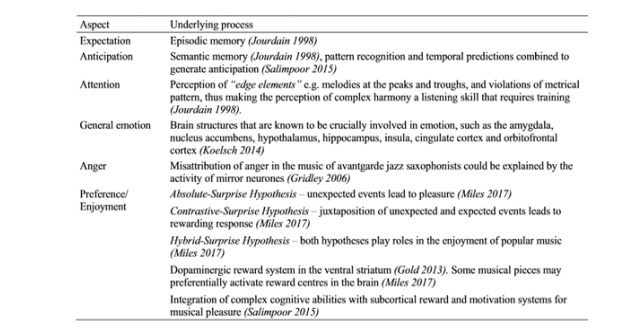
[Adapted from Wang and Agius (2018)]
Several studies (Koelsch, 2010; Levinson, 2000; Juslin, and Västfjäll, 2008) confirm that a formal practice of music results in noticeable changes in the functional structure of specific regions of the brain (cerebellum, corpus callosum, motor cortex, planum temporale). There are other studies (Bever and Chiarello, 1974; Kimura, 1995; Koelsch, 2005) that confirm that practicing music produces several modifications in the cerebral system of the music practitioners.
Music seems a whole brain exercise; whilst our right hemisphere is associated with natural occurrence in music, that is linked to melody and timbre; on the other hand, the left hemisphere is linked to rhythm and analytical aspects. This has also been demonstrated by fMRI studies that have also found that trained musicians display certain particularities (Bever and Chiarello, 1974; Koelsch, 2005). Music as a therapy is not widely used, despite the fact the research data clearly demonstrate the biochemical changes in the brain, which also include increase dopaminergic transmission (Sutoo and Akiyama, 2004).
Sarkamo et al (2008) study that was carried out in stroke patients, demonstrated that subjects who listened to their favourite music at least one hour daily displayed improvements in attention and mood (Sarkamo et al., 2008). Music therapy programmes have a similarly beneficial impact on anxiety and depression in patients hospitalised due to brain lesions caused by trauma (Guétin et al, 2009). In the elderly population, listening to music may mitigate hearing loss, facilitate comprehension, and delay cognitive decline (Alain et al, 2014).
Discussion and Conclusion
It is evident that ancient Indian scholars were well aware of the benefits of practicing mantras, although during Vedic period mantras were chanted around the sacred fire, and as the civilisation developed in India it took the form of Bhakti Yoga, which is singing the praise of divine and nowadays we have various (classical, folk music, filmi, Indian/western rock, and pop) forms of music.
The study highlights that ancient Indian scholars were not wrong in stating that our body is a vessel for the manifestation of “sound”, which is known as Nada Brahman (God as Divine Sound), and our voice acts as an access point for music.
Ancient Rishis’s (Ancient India Scholars) through Upanishads highlighted that the sacred syllable Om is the primordial sound from which all other sounds and creation emerge. It underlies all phonetic creations. The utterance of Om, consisting of the three letters A, U, and M, covers the whole process of articulation. It is like the sound of a gong that gradually tapers to a point and merges in silence. One who attains Om, merges with the Absolute (Kumar et al, 2010).
It is confirmed that the human brain and nervous system are hard-wired to distinguish music from noise and to respond to rhythm and repetition, tones and tunes. All human beings are born with an innate capability for music and we all have this built-in biological circuitry which makes us naturally either like the music or produce the music; however, the biological circuity is more effective in those practicing and producing music, as compared to others.
The study also highlights that musicians who practice music on a regular basis have a large brain and this also supports the argument that the people who have been chanting mantras regularly or as part of their profession may also have a large brain. Transcendence or divinity is all experienced through our brain, and several scientific studies now confirm that our brain is plastic and this study highlight that mantras and music can be used as a tool.
It is evident that music does enhance human health and performance and for that reason music is connected with anxiolytic and analgesic properties and it is today used in many hospitals to help patients relax and relieve or ease pain, confusion and anxiety. Mantras and music can trigger memories, or awaken emotions and intensify our social experiences. When we sing or listen good solo music, we all have a pleasant tingling feeling, raised body hairs and gooseflesh (frisson).
Many of us may not be a trained singer or have a chance to become one, but we all certainly have the biological circuitry within us that enable us to chant few mantras – that may push our biological circuitry which may change our brain plasticity and enhance our quality of life. However, one important point one need to keep in mind while chanting a mantra is the pronunciation of vowels (svar) and consonants (varna).
Ancient Indian Scholars believed that correct pronunciation of mantras (sound) plus the faith or intent with which these mantras are uttered, brings the desired beneficial effects to the meditators, which I am sure science will catch up with, in the future.
***
(Editor’s note: This paper is not peer reviewed)
***
Author: Dr Dinesh Bist SFHEA (London)
Email of the author: dineshbist@hotmail.com
The views and opinions expressed on this website are solely those of the author(s) and other contributor(s), if any.
***
References:
- Alain C., Zendel B. R., Hutka S., Bidelman G. M. (2014). Turning down the noise: the benefit of musical training on the aging auditory brain. Hear. Res. 308, 162–173 10.1016/j.heares.2013.06.008
- Arias, M. (2014) Music and the brain: neuromusicology, Neurosciences and History, vol.2 (4), p;149-155.
- Bist, D. (2019) Exploring the potential of Human Body and Brain to Synchronise with Earth Electromagnetic Resonance and Schumann Resonance, International Journal of Hinduism & Philosophy (IJHP, http://www.bgrfuk.org/
- Beck, G. L. (1994) Variations on a Vedic Theme: The Divine Names in the Gayatri Mantra, Journal of Vaishnava Studies, vol. 2 (2), p; 47-58.
- Beck, G. L. (2009) Sonic Theology: Hinduism and Sacred Sound (Studies in Comparative Religion): University South Carolina Press. Becker, J. (2004) Deep Listeners: Music, Emotion, and Trancing, Bloomington, IN: Indiana University Press.
- Becker, J. (2004) Deep Listeners: Music, Emotion, and Trancing, Bloomington, IN: Indiana University Press.
- Bever, T.G. and Chiarello, R. J. (1974) Cerebral dominance in musicians and non-musicians, Science, vol. 185, p; 537-539.
- Bhaktivedanta, S. A.C. (1972- 1989) Trans. Srimad-Bhagavatam, New York and Los Angeles: Bhaktivedanta, Book Trust.
- Blood, A. J. and Zatorre, R. J. (2001) Intensely pleasurable responses to music correlate with activity in brain regions implicated in reward and emotion. Proc. Natl. Acad. Sci, vol. 98, p; 11818– 11823.
- Bryant, E. F. and Patton, L. L. (2005) The Indo-Aryan Controversy: Evidence and Inference in Indian History, New York: Routledg.
- Chnimayananda, S. (2017) Mandukya Upanishad with Gaudapada’s Karika, Central Chinmaya Mission Trust, Chinmaya Prakashan, Mumbai India.
- Chinmayananda, S. (1974) Discourses on Taittiriya Upanishad, Publisher: Chinmaya Publications Trust, ASIN: B0000D5P54
- Cooke D. (1959) The language of music. Oxford: Oxford University Press.
- Cromie, W. J. (2001) “Music on the brain: Researchers explore the biology of music” Harvard Gazette, Harvard University.
- Das, S. (2015) Indian Dramaturgy: A historical view of Bhartiya Natyashastra, An International journal Referred e-journal of Literacy Exploration ISSN 2320 -6101.
- Dudeja, J.P. (2017) Scientific Analysis of Mantra-Based Meditation and Its Beneficial Effects: An Overview, International Journal of Advanced Scientific Technologies in Engineering and Management Sciences, vol. 3 (6).
- Easwaran, E. (2007) The Upanishads, Nilgiri Press, Blue mountain centre of meditation, Canada.
- Frawley, D. (1994) Tantric Yoga and the Wisdom Goddesses: Spiritual Secrets of Ayurveda, Lotus Press USA, Passage Press Salt Lake City Utah.
- Gabrielsson, A. (2011) “Strong experiences with music,” in Handbook of Music and Emotion: Theory, Research, New York: Oxford University Press, p; 547–574.
- Gambhirananda, S. (2009) Chandogya Upanishad – With the Commentary of Shankaracharya, Publisher: Advaita Ashrama; 6th edition, ISBN-10: 8175051000, ISBN-13: 978-8175051003.
- Gambhirananda, S. (2010) Prasna Upanishad- With the Commentary of Shankaracharya, Publisher: Advaita Ashrama, India ISBN-10: 8175050233, ISBN-13: 978-8175050235.
- Gambhirananda, S. (2010) Katha Upanishad With the Commentary of Shankaracharya, Publisher: Advaita Ashrama, India; 2 edition, ISBN-10: 8185301336, ISBN-13: 978-8185301334.
- Gambhirananda, S. (2010) Mandukya Upanishad- With the Commentary of Shankaracharya, Publisher: Advaita Ashrama, India, ISBN-10: 8175050993, ISBN-13: 978-8175050990.
- Gerety, F. M. M. (2015) This Whole World is OM: Song, Soteriology, and the Emergence of the Sacred Syllable, Ph.D. dissertation, Harvard University.
- Gold, B. P., Frank, M. J., Bogert, B. and Brattico, E. (2013) Pleasurable music affects reinforcement learning according to the listener, Front Psychology, vol. 4 (541).
- Guétin, S., Portet, F., Picot, M.C., Pommié, C., Messaoudi, M., Djabelkir, L., Olsen, A.L., Cano, M.M., Lecourt, E., and Touchon, J. (2009) Effect of Music Therapy on Anxiety and Depression in Patients with Alzheimer’s Type Dementia: Randomised, Controlled Study, Dementia and Geriatric and Cognitive Disorders, Online Research Article, Dement Geriatr Cogn Disord 2009;28:36–46. (DOI: 10.1159/000229024)
- Grewe, O., Nagel, F., Kopiez, R. and Altenmüller, E. (2007) Listening to music as a re-creative process: physiological, psychological, and psychoacoustical correlates of chills and strong emotions, Music Percept, vol. 24, p; 297–314.
- Gridley, M. (2006) Do Mirror Neurons Explain Misattribution of Emotions in Music? Percept Mot Skills, vol. 102, p; 600-602.
- Harrison, L. and Loui, P. (2014) Thrills, chills, frissons, and skin orgasms: toward an integrative model of transcendent psychophysiological experiences in music, vol. 5 (article 790).
- Hickok, G. (2003) Auditory–Motor Interaction Revealed by fMRI: Speech, Music, and Working Memory in Area Spt music and emotion, Journal of Cognitive Neuroscience, vol. 15, p; 673-682.
- Huron, D. and Margulis, E. H. (2011) “Music expectancy and thrills” in, Handbook of Music and Emotion: Theory, Research, Applications, (p; 575–604) New York: Oxford University Press.
- Jourdain R. (1998) Music, the brain, and ecstasy: How music captures our imagination, New York, NY, US: Avon Books.
- Juslin, P. N., and Västfjäll, D. (2008) Emotional responses to music: the need to consider underlying mechanisms. Behaviour, Brain Science, vol. 31, p; 559–575.
- Kimura, D. (1964) Left-right differences in the perception of melodies, Q J Exp Psychol, vol. 16, p; 355-358.
- Kochhar, R. (2000) The Vedic People: Their History and Geography, New Delhi: Orient Longman.
- Krishnananda S (1951) Mundaka Upanishad, Available at: https://www.swamikrishnananda.org/mundaka_0.html [Accessed on Jan 2020].
- Koelsch, S. (2005) Neural substrates of processing syntax and semantics in music, Curr Opin Neurobiology, vol. 15, p; 207-212.
- Koelsch, S. (2010) Towards a neural basis of music-evoked emotions, Trends Cognitive Science, vol. 14, p; 131– 137.
- Koelsch, S. (2014) Brain correlates of music-evoked emotions, Nat Rev Neuroscience, vol. 15, p; 170-180.
- Kumar, S., Nagendra, H. R., Manjunath, N. K., Naveen, K. V. and Telles, S. (2010) Meditation on OM: Relevance from ancient texts and contemporary science, International Journal of Yoga, vol. 3 (1), p; 2-5.
- Lefevre, M. (2004). Playing with sound: the therapeutic use of music in direct work with children. Child and Family Social Work, 9, 333-345.
- Levinson, J. (2000) Musical frissons, Rev. Fr. Etud. Am, vol. 86, p; 64–76.
- Lewis, P. A. (2002) Musical minds, Trends Cognitive Science, vol. 6, p; 364-366.
- Ley, G. (2000) Aristotle’s Poetics, Bharatamuni’s Natyasastra, and Zeami’s Treatises: Theory as Discourse: Asian Theatre Journal, Vol. 17, No. 2 (Autumn, 2000), pp. 191-214 Published by: University of Hawai’i Press Stable URL: http://www.jstor.org/stable/1124489 Accessed: 16/02/2020
- Madhavananda, S. (1950) The Brhadaranyaka Upanihsad, 3rd edition, Advaita Ashram, Mayavati, Almora, Himalayas, India, Available at: http://www.holybooks.com/wpcontent/uploads/Brihadaranyaka-Upanishad.pdf.
- Mah, K. and Binik, Y. M. (2001) The nature of human orgasm: a critical review of major trends, Clinical Psychology Review, vol. 21, p; 823–856.
- Maslow, A. H. (1962) Lessons from peak experiences, Journal of Humanistic Psychology, vol. 2, p; 9–18.
- Maslow, A.H. (1964) Religions, values, and peak-experiences, Columbus: Ohio State University Press.
- Merchant, H. and Averbeck, B. B. (2017) The Computational and Neural Basis of Rhythmic Timing in Medial Premotor Cortex, Journal of Neuroscience, vol. 37, p; 4552-4564.
- Meyer, L. B. (1956) Emotion and meaning in music, Chicago, The University of Chicago Press.
- Miles, S. A., Rosen, D. S. and Grzywacz, N. M. (2017) A Statistical Analysis of the Relationship between Harmonic Surprise and Preference in Popular Music, Front. Hum. Neuroscience, vol. 11 (263).
- Molnar-Szakacs I, Overy K: Music and mirror neurons: from motion to ‘e’motion. SocCogn Affect Neurosci 2006; 1:235-41
- Mula, M. (2009) Trimble MR: Music and madness: neuropsychiatric aspects of music, Clinical Med, vol. 9, p; 83-86.
- Oldenberg, H. (1988-1894) The Religion of the Veda, English Translation from original German, Shridhar B. Shrotri, Delhi: Motilal Banarsidass.
- Olivelle, P. (1996) Oxford world classic Upanishad, Cox & Wyman Ltd, Reading, Berkshire, GB.
- Overy, K., Norton. A. C., Cronin, K. T., Gaab, N., Alsop, D. C., Winner, E. and Schlaug, G. (2004) Imaging melody and rhythm processing in young children, Neuroreport, vol. 15, p; 1723-1726.
- Padoux, A. V. (1990) The Concept of the Word in Selected Hindu Tantras, Albany, NY: SUNY Press.
- Panksepp, J. (1995) The emotional sources of “chills” induced by music, Music Percept, vol. 13, p; 171–207.
- Patel, A. D. (2008) “Music as a transformative technology of the mind,” in Proceedings of the symposium at Music: Its Evolution, Cognitive Basis, and Spiritual Dimensions, Cambridge.
- Perret, D. (2004) Roots of musicality: on neuro-musical thresholds and new evidence for bridges between musical expression and inner growth, Music Education Research, vol. 6, p; 327-342.
- Prajnanananda, S. (1963) A History of Indian Music – Volume One: Ancient Period, Sri Ramakrishna Math, 2nd edition.
- Raghavan, V. (1978) Music in Sanskrit Literature, National Centre for the Performing Arts, Quarterly Journal, vol. 7 (4), p; 17–38.
- Rauschecker, J. P. (2014) Is there a tape recorder in your head? How the brain stores and retrieves musical melodies, Front Syst Neuroscience, vol. 8 (149).
- Rauscher, F. H., Shaw, G. L. and Ky, K. N. (1995) Listening to Mozart enhances spatial-temporal reasoning: towards a neurophysiological basis, Neurosci Lett, vol. 185, p; 44-47.
- Roehmann, F. L. (1991) Making the connection, Music Educator’s Journal, vol. 77, p; 21-25.
- Salimpoor, V. N., Zald, D. H., Zatorre, R. J., Dagher, A. and McIntosh, A. R. (2015) Predictions and the brain: how musical sounds become rewarding, Trends Cogn Science, vol. 19, p; 86-91.
- Sarkamo, T., Tervaniemi, M., Laitinen, S., Forsblom, A., Soinila, S. and Mikkonen, M. (2008) Music listening enhances cognitive recovery and mood after middle cerebral artery stroke, Brain, vol. 131, p; 866-876.
- Schlagintweit Emil 2019. Wikimedia Image- Om Mani Padme Hum. Available online at https://upload.wikimedia.org/wikipedia/commons/7/76/Priere-6-syllabes-Om-Mani-Padme-Hum.jpghttps://upload.wikimedia.org/wikipedia/commons/7/76/Priere-6-syllabes-Om-Mani-Padme-Hum.jpg Accessed on 06 May 2020.
- Schlaug, G., Norton, A., Overy, K. and Winner, E. (2005) Effects of music training on the child’s brain and cognitive development, Ann N Y Acad Science, vol. 1060, p; 219-230.
- Sharma, S. A. (2011) The Integrated Science of Yajna, Shantikunj, Haridwar.
- Stewart, L. (2005) A neurocognitive approach to music reading, Ann N Y Acad Science, vol. 1060, p;377-386.
- Sutoo, D. and Akiyama, K. (2004) Music improves dopaminergic neurotransmission: demonstration based on the effect of music on blood pressure regulation, Brain Res, vol. 1016, p; 255-262.
- Thomas, S. and Shobini, L. R. (2018) Effect of Gayatri Mantra Meditation on Meditation Naive Subjects: an EEG and fMRI Pilot Study, The International Journal of Indian Psychology, vol. 3 (2).
- Walis, D.C. and Ellik, E. (2013) Tantra Illuminated: The Philosophy, History and Practice of Timeless Tradition, 2nd Edition.
- Wang S. and Agius M. 2018. THE NEUROSCIENCE OF MUSIC; A REVIEW AND SUMMARY. Psychiatria Danubina, 2018; Vol. 30, Suppl. 7, pp 588-594. Available online at http://www.psychiatria-danubina.com/UserDocsImages/pdf/dnb_vol30_noSuppl%207/dnb_vol30_noSuppl%207_588.pdf/
- Weinberger, N. M. (2004) Music and the Brain, Scientific American, vol. 291, p; 88-95.
- Zatorre, R. J., Chen, J. L. and Penhune, V. B. (2007) When the brain plays music: auditory-motor interactions in music perception and production, Nat Rev Neuroscience, vol. 8, p; 547-558
